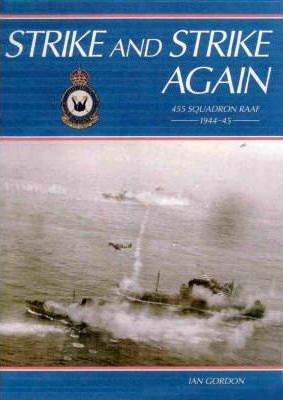Mr Gordon served for nearly 40 years in the Australian Army and has a family connection with 455 Squadron RAAF, in that his father served as a Beaufighter navigator in the squadron. The aircrew of this unit were largely products of the Empire Air Training Scheme and joined the conflict in the U.K. It was always intended that the squadron, in concert with other similarly numbered squadrons would be composed of Australians. This was never completely achieved.

Gordon, Catherine G., (illustrator.)
West Geelong, Victoria Echo Books, 2015
First published by Banner Books 1995
ISBN: 9780994355881
244pages, Appendices, Notes, Bibliography and Index
Early in the war as Commonwealth trained aircrew arrived in the U.K. they were often allocated to R.A.F. Squadrons on a needs basis and it was only later in the war that 455 Sqn became almost all Australian aircrew. The Squadron was formed at RAAF Williamtown in May 1941 with two officers and 232 ground crew. The Squadron was also officially formed in the U.K. as part of Bomber Command at about the same time and the Australian element arrived in September. Meanwhile a skeleton RAF ground staff enabled the Squadron to fly its first operation with Hampden aircraft to Frankfurt on 29th August 1941.
The squadrons’ service with Bomber Command lasted less than 12 months. Due to the escape of the Scharnhorst and Gneisenau through the English Channel a reorganisation saw 455 Sqn allocated to an enlarged Coastal Command. The Squadrons’ Operations were henceforth directed against enemy shipping and were conducted almost always at extremely low altitude. The Squadron were declared operational with the Hampden in a torpedo dropping role in July 1942.
For a while the Squadron was based in Russia and operated around the North coast of Norway in very arduous conditions. The Squadron returned to the U.K. and by December 1943 was based at Leuchars Scotland and converting to the Beaufighter. This was a fast, tough and deadly attack aircraft, ideal for the anti-shipping role. It could be operated as a torpedo dropping aircraft (Torbeau) or a Flak suppression and air to surface attack aircraft with four 20mm cannon and later rockets. In concert with other Australian and New Zealand Beaufighter squadrons, tactics were refined until an effective method of attack was devised. This usually entailed two squadrons of Flak suppression Beaufighters attacking enemy escort ships first, closely followed by a Torbeau attack on the merchant shipping. Later there was also top cover flown by Mustang fighters. It was not unusual to have a force of 60 to 80 Beaufighters involved in an operation. The Operational planning relied very much on intelligence to intercept enemy convoys. The main strategic aim was to interrupt the flow of strategic materials from Sweden and Norway to Germany. This entailed attacks in open water, close to the coast and highly dangerous attacks within Norwegian Fiords. At all times, enemy flak was very heavy, often leading to significant losses of aircraft.
The Squadron operated from several bases in the U.K. but the most important were Dallachy near Peterhead in Scotland and Langham in Norfolk.
The book is replete with personal reminiscences and there are many action photos taken during low level strikes. It is a pity that the photos are not printed on glossy paper as this would have enhanced the visual quality, they are however acceptable. There are many line drawings of maps covering individual raids. The work of the Australian ground crew in often hideous conditions is beyond praise and is well acknowledged.
The appendices are very informative and add much personal detail and explanatory information. The book strikes a nice balance between general appeal and interest for the professional.
Reviewed for RUSIV by Brian Surtees, February 2017
Contact Royal United Services Institute about this article.






